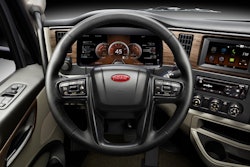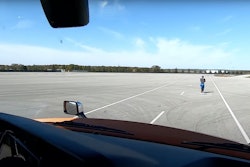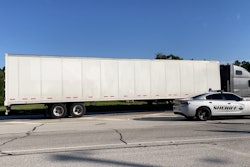Advanced driver assistance systems (ADAS), such as forward collision warning, automatic emergency braking, lane keeping assist, adaptive cruise control, camera-based mirrors, and blind-spot warning systems, are becoming commonplace on new Class 8 highway trucks. These systems are also gaining acceptance as options on some medium- and heavy-duty work trucks.
Exact take rates for ADAS are hard to pin down. ADAS on Class 8 on-highway tractors makes for a compelling and measurable use case. So much so, that the various ADAS systems are typically bundled and provided as standard equipment on the most popular heavy-duty freight haulers. So, a Class 8 OEM will tend to speak of overall acceptance rates by fleets, but not break it down into what percentage of fleets spec’ed, say, automatic engine braking or lane-keeping assist.
“The take rate for ADAS on-highway trucks is approximately 90%,” a Daimler Truck North America (DTNA) spokesperson told CCJ. That impressive figure no doubt reflects the positioning of DTNA’s Detroit Assurance suite of ADAS technologies as standard equipment on its Freightliner Class 8 Cascadia models equipped with a Detroit engine and Detroit DT12 or manual transmission.
“Gauging the popularity of a feature, or framing them in that manner, can be a somewhat ‘mysterious’ exercise,” said TJ Thomas, director, Marketing & Customer Solutions – Controls Group, for Bendix Commercial Vehicle Systems, a major supplier of ADAS systems. “That’s because each truck manufacturer may implement differing feature sets of a technology, as applicable, over time. We encourage fleets to check with their OEM or dealer to determine what features and performance capabilities are available for a vehicle.”
For vocational trucks, regardless of GVW, not all ADAS options may offer a high enough return on investment to warrant spec’ing all of them in a given application or duty cycle. Systems such as adaptive cruise control and camera-based mirrors may be seen as superfluous on trucks that spend more time in the dirt than on the road.
Studies make strong case
However, studies clearly indicate that ADAS systems do greatly reduce on-highway truck crashes. The National Highway Administration (NHTSA) estimates that automatic emergency braking (AEB) alone could prevent more than 11,000 crashes, 7,700 injuries, and more than 170 deaths involving heavy vehicles.
Per FMCSA, researchers at the University of Michigan Transportation Research Institute have found that, by themselves, lane-departure warning reduces crashes by 14%; electronic stability control by 19%; forward collision warning by 14%, and blind spot warning by 5%.
And equipping a large truck with just AEB and forward-collision warning could eliminate more than 2 out of 5 crashes in which a large truck rear-ends another vehicle, suggests an Insurance Institute for Highway Safety (IIHS) study.
IIHS Director of Statistical Services Eric Teoh examined data on crashes per vehicle mile traveled from 62 carriers operating tractor-trailers and other trucks weighing at least 33,000 pounds. From there, he determined that that trucks equipped with forward-collision warning had 22% fewer crashes and trucks with AEB had 12% fewer crashes than those without either technology. Along with that, Teoh found that forward-collision warning and AEB reduced rear-end crashes — the specific type of collision that they’re designed to prevent — by 44% and 41%, respectively.
Teoh said the study delivers evidence that “forward-collision warning and AEB greatly reduce crash risk for tractor-trailers and other large trucks. That’s important information for trucking companies and drivers who are weighing the costs and benefits of these options on their next vehicles.”
Pushing ADAS acceptance
Via its Tech-Celerate Now (NOW) program, the Federal Motor Carrier Safety Administration (FMCSA) aims to hasten the adoption of ADAS in commercial vehicles. This effort receives funding and technical support from the Transportation Department’s Intelligent Transportation Systems Joint Program Office.
Starting this autumn, FMCSA plans to “reengage with key industry associations and to partner with new stakeholders” in a second phase of NOW aimed at driving up ADAS acceptance by truck operators.
Phase 2 of Tech-Celerate Now will:
- Develop a project management plan
- Conduct research on technical and market barriers to adoption of ADAS
- Develop outreach materials for fleets and owner-operators
- Develop best practices for fleets and owner-operators
- Conduct national outreach campaign for fleets and owner-operators to implement ADAS
- Conduct data collection and analysis of outreach impacts, industry trends, technology trends, and deployment rates
More to come
Like any advanced technology worth that billing, the various ADAS systems keep evolving as refinements are made and new features are added. But that’s no reason to wait to take advantage of ADAS, whether as standard equipment or by selecting it optionally, depending on the truck model.
What’s more, the safety suite that is ADAS is also a waystation on the long winding road to the full automation of commercial trucks. Current ADAS technology, taken as a whole, pushes against the envelope that is Level 2 of the six SAE Levels of Driving Automation. ADAS sits squarely on the dividing line between the most advanced level of driver-support tech and the first level of automated driving. And that underscores that the safety performance of these systems will continue to advance.
“We say it often, but it bears repeating that safe operation and control of the vehicle remains the responsibility of the driver at all times,” said Bendix’s Thomas. “Collision-mitigation technology does not replace the need for skilled drivers using safe driving practices and the driver always in control of the vehicle.
“Collision mitigation technologies are designed to help mitigate rear-end collisions and, with stability control, help to reduce rollovers and loss-of-control situations,” he continues. “None of these technologies, however, will prevent all the occurrences of these types of crashes. Regrettably, we have to face the fact that there are more types of crashes than technologies that exist to cost-effectively mitigate them. And there are more conditions that go into a crash, from weather and road surface conditions to driver attentiveness and vehicle maintenance, to name a few.”












